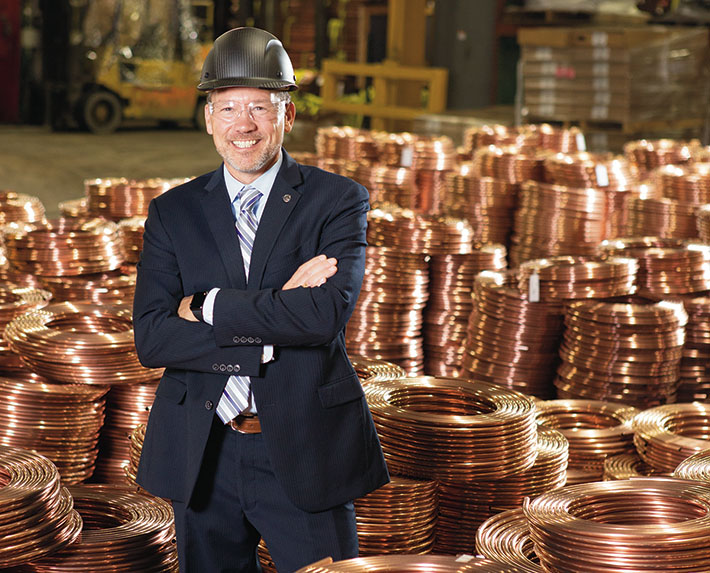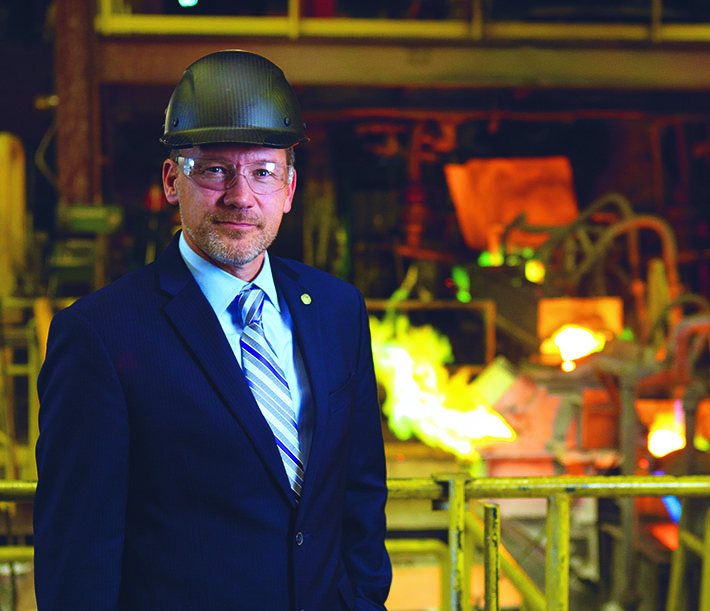
Q & A with Andrew G. Kireta Jr.
Andy Kireta does a lot of running, both figuratively and literally. As vice president, market development, for the Copper Development Association Inc. (CDA), Kireta helps run the not-for-profit trade association that serves as the world’s foremost resource on copper and copper alloy applications.
As an “ultramathoner,” Kireta often rises before 5 a.m. to run, preparing for races like the 50-mile ultramarathon he ran last October. “When I’m not writing standards, I’m out running crazy distances,” he laughs, remembering that race fondly. “I’m not exactly sure why I did it, but I did it.”
An ASTM International member since 1998, Kireta works on the committee on copper and copper alloys (B05) and several of its subcommittees. He previously served as B05 membership secretary and is the current chair of the subcommittee on awards (B05.92). A 2016 Award of Merit recipient, Kireta has also been honored with the Copper Club Award and the Arthur Cohen Memorial Distinguished Service Award for his work on the committee. He joined the board in 2014 and previously served as Board Vice Chair and Chair of the Finance and Audit Committee.
Kireta began his work with the CDA in 1992 as midwest regional manager and held management positions for tube, pipe and fittings, and architectural applications before becoming vice president, building construction, in 2008. He assumed his current role at CDA in 2010. As CDA vice president, Kireta promotes the use of copper and copper alloy systems and related products in both building construction and sustainable energy applications.
Kireta is also a proud alumnus of Purdue University, where he received a bachelor’s degree in mechanical engineering.
Q. Tell us about your work with the Copper Development Association and how you first became involved in the copper industry.
A. The Copper Development Association represents the copper and copper alloy value chain from mined products all the way through semi-finished and fabricated products: anything from tube and pipe to electrical products. We’re in many markets, from automotive to plumbing, and our members consist of mining companies that produce refined copper and fabricators and wire mills that turn the refined copper into finished products.
FOR YOU: An Interview with Taco Van Der Maten, 2019 Board Chair
I've been with the Copper Development Association since 1992. Previously I had worked on nuclear power plant piping design as a mechanical engineer. The CDA was looking for someone to represent the copper piping markets to promote copper, to work on codes and standards, and to be a go-between linking the manufacturing and sale of the product to end-use design and engineering. So I’ve worked my way up through the organization over the past 27 years. And now as vice president of market development, I'm responsible for copper and copper alloy product used across all markets in North America, mainly in the U.S. and Canada.
Q. How are standards used in the copper industry, and what have they meant to its overall history and development?
A. Standards are extremely important to the copper industry. Copper is one of the oldest metals used by mankind. It has been used for thousands of years, but it only becomes effective in use across economies and across societies if the product performance can be standardized so that the end user knows what to expect, and the manufacturer knows what to produce. In most cases, the standards that we write for copper are really the marriage of the performance expectation and the reality of manufacturing. That way, every person in the value chain, every stakeholder, when they buy that product, they know what it's going to do and how they can design with it.
On the other hand, the manufacturer knows what that product needs to do in the marketplace to be successful: what kind of properties it has to deliver, what kind of performance it has to deliver. That's why working on standards in the ASTM process has been important. It's an opportunity to bring all the stakeholders together where they can sit at the same table, give input, and come up with a standard and a product at the end of the day that manufacturers can produce efficiently, effectively,
and profitably.

Kireta has been involved in the copper industry since 1992.
Q. Over the last 20 years, the copper market has seen extraordinary growth. How is the current economic climate affecting the copper industry?
A. The current economic climate for the copper industry really brings two terms to mind: opportunity and challenge. Opportunity because there are a lot of very interesting applications occurring because of global political and scientific trends on low-carbon economies such as renewable power production and cleaner energy. This is opening up new markets and new technologies where copper plays a key role. One of copper's main benefits is its high electrical conductivity. So any application where we are going to rely on electricity — and renewable energy to create that electricity — copper is going to play a major role: electric vehicles, electric transportation, the charging infrastructure. The systems that deliver energy from wind farms or solar PV farms, distributed energy in a building, these systems will all see heavy copper use, and copper will be responsible for the success and reliability of those systems.
Q. ASTM International recently signed its 113th memorandum of understanding. How do you see ASTM continuing to grow as an international standards developer in the future?
A. In the future, ASTM is going to continue to grow its international presence and international participation. This will be driven by the standards that are important in a given geographic region, for example, building construction and petroleum in the Middle East; additive manufacturing in Singapore. We're reaching out to these markets to find out what's important to them and where there might be the need for standards development. But it’s going to go far beyond standards.
ASTM is looking at changing its model of engagement and participation in international markets. We recently created an ASTM chapter in the United Arab Emirates to give local participants a means to get together, network, find opportunities, and develop standards. We are currently looking as a board at another international chapter — perhaps in Peru — to generate more interest from the South American market, which is an important market for ASTM International standards.
Q. You’ve been involved with ASTM International for over 20 years, and you’ve served on the board of directors. How have you seen ASTM grow and change in this time?
A. In my time with ASTM International, I've seen significant growth and change in how ASTM approaches what they do. Twenty years ago when I started, the perception was that ASTM was around to write a standard, publish it in a book, and ship the book out so that users could use that.
But over the years, ASTM has evolved from a standards developer to a solutions provider. The key strength of the ASTM process has always been bringing together all stakeholders to write the technical content of a standard. You get every part of the value chain involved in the process: users, manufacturers, government, general interest, all able and willing to give their input and all having an equal voice.
The development of ASTM’s Compass platform is one change I’ve seen recently. Companies can use this platform as a way to get their standards but also as a way to help them write internal company standards; to pool ASTM content and other standards developer content into their standards; and generate positions that are consensus within their company before they come to ASTM meetings to revise or write new standards.
Q. One of ASTM International’s goals is to make standards part of the product development process at the earliest stages, linking them with innovation. How do you go about accomplishing this?
A. Building a product and writing a standard afterwards misses the point. A key strength of the ASTM process is that you’re bringing the user together with the manufacturer to find out what's important to the user and what needs to be accommodated in the manufacturing portion of the product cycle. The user needs to have the correct perception in their mind of what can be manufactured. And the best way to accomplish this is early on in the process as you're doing research and development.
ASTM International has worked over the past couple of years to try to facilitate this and engage new industries. They've opened the Additive Manufacturing Center of Excellence at Auburn University, which brings together NASA, Auburn, Edison Welding Institute (EWI), and others to develop new technologies for additive manufacturing and to help standardize those things that everyone can benefit from in a pre-competitive environment. In addition, the requirement for participation in this center of excellence is that every piece of research they do has to have a standards output so they can't be doing product research without thinking, “How do I incorporate this into a standard right from the start?”
Recently, ASTM also announced its Exo Technologies Center of Excellence. The center will be dedicated to early research on the application, development, and use of these products and systems, but with the end output having some kind of standards element.
Q. 2019 was a big year for ASTM International with regard to diversity and inclusion. How can we keep the momentum going in 2020?
A. Kathie Morgan really stepped up as president in 2019, signing the U.N.’s Gender Responsive Standards Initiative and helping engage women in STEM [science, technology, engineering, math] to promote their involvement in standards development. In 2020, the board has another objective for Kathie, and that’s to continue to diversify ASTM International’s staff, ASTM’s governance at the board level, and to help facilitate ASTM’s membership diversity.
At the governance level, the ASTM International board always tries to have diverse opinions from the committees represented. Old line committees like copper, aluminum, steel, and petroleum have voices, but they're balanced now with new committees like exoskeletons, additive manufacturing, aerospace, and commercial spaceflight.
Another exciting thing is this year's class of incoming board members. Starting in January, of six new board members, five will be women, which brings the representation of women on the board to eight out of 24 board members.
 SN Home
SN Home Archive
Archive Advertisers
Advertisers Masthead
Masthead RateCard
RateCard Subscribe
Subscribe Email Editor
Email Editor